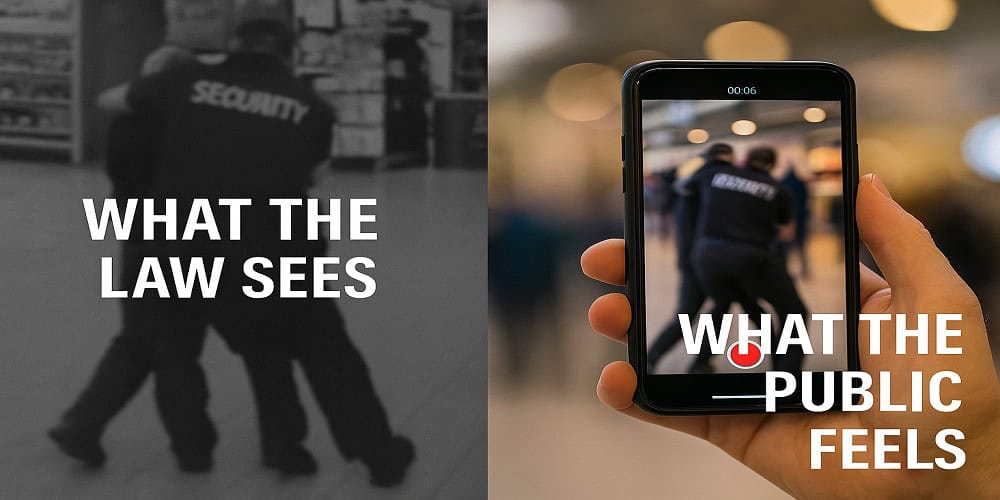Calgary Co-Op Arrest: What Security Guards Can Learn About Use of Force and Public Perception

Last Updated on April 25, 2025
A recent security incident at the Brentwood Calgary Co-Op has gone viral, sparking renewed debate about use of force, the legal authority of security guards in Canada, and the growing role public perception plays in shaping industry policies. The event, which took place around February 28, 2025, involved a security guard detaining an alleged shoplifter in what witnesses described as an “aggressive” takedown—one bystander even compared it to a WWE match.
As the video circulated online, the discussion quickly shifted from legality to optics. While no charges have been laid, the situation underscores the complex balance between law enforcement by private security and maintaining the public’s trust.
In this post, we break down key lessons from the Calgary Co-Op incident for security guards and loss prevention professionals, including legal guidelines, best practices, and the critical impact of public perception in today’s social media-driven world.
Understanding Citizen’s Arrest in Canada
Under Section 494 of the Criminal Code of Canada, private citizens—including security guards—can make a citizen’s arrest if:
- They witness someone committing a criminal offence.
- They are the property owner or authorized to act on behalf of the property owner and witness a crime on or related to that property.
- The arrest happens at the time of the offence or shortly after, and waiting for a peace officer is impractical.
- The person detained must be handed over to law enforcement promptly.
For loss prevention officers, this means the arrest must be based on direct observation. If a guard did not witness the theft from start to finish, the arrest could be considered unlawful, risking charges like assault or forcible confinement.
Use of Force: What the Law Says
Security guards are legally private citizens. Their authority to use force comes from Section 25 of the Criminal Code, which allows individuals acting under lawful authority to use reasonable force when necessary.
Key factors to consider:
- Proportionality: The amount of force must match the threat or resistance.
- Necessity: Force should only be used when other options, like verbal commands, have failed.
- Reasonable judgement: Excessive or unnecessary force can result in criminal charges, lawsuits, and job loss.
Examples of appropriate force:
- Cooperative subject? Use verbal commands and non-threatening body language.
- Resisting or fleeing suspect? Reasonable physical restraint may be justified.
- Active threat? Handcuffs may be used, but only with clear justification and proper technique.
In the Calgary Co-Op case, public backlash was less about the legality and more about optics—how the force looked to bystanders. This is a growing reality in the security industry: perception often outweighs legal nuance.
The Role of Loss Prevention Professionals (LPPs)
LPPs are on the front lines of retail security. Their core responsibilities include:
- Monitoring and preventing theft.
- Gathering evidence through surveillance.
- Detaining suspects within the scope of their legal authority.
- Ensuring safety for staff, customers, and themselves.
Best practices for loss prevention:
- Follow the six-step method: Observe, Approach, Selection, Concealment, Continuous Observation, and Exit.
- Start with communication: Always attempt voluntary compliance first.
- Use non-threatening posture to de-escalate potential confrontations.
- Document everything: Detailed notes and incident reports protect you during reviews and investigations.
The Calgary incident shows how one video can turn a routine arrest into a viral controversy, affecting both the security company and the retailer’s reputation.
Legal, Physical, and Reputational Risks for Security Guards
Security work comes with serious risks, especially when making arrests:
Legal Risks:
- Criminal charges from alleged unlawful arrests or excessive force.
- Civil lawsuits for injuries or emotional distress.
Safety Risks:
- Injury during altercations.
- Weapons or violent retaliation from suspects.
- Off-duty retaliation.
Reputational Risks:
- Viral videos leading to media scrutiny.
- Loss of employment—even when actions were lawful.
- Long-term damage to career prospects in the industry.
Security guards must balance enforcement with legal compliance, personal safety, and protecting their employer’s brand image.
Why Public Perception Matters More Than Ever
The Calgary Co-Op arrest serves as a powerful example of how public opinion can override legal context:
- Media reports focused on the witnesses’ emotional reactions, not legal analysis.
- Viral footage shapes the narrative more than police statements or internal policies.
- Even if legal, forceful actions that “look bad” can lead to firing, protests, or damaged reputations.
How public opinion shapes security practices:
- Some retailers prohibit force altogether.
- Companies may terminate guards to avoid backlash—even when justified.
- Guards who appear “too aggressive” may struggle to find future employment.
Key Takeaways for Security Guards and LPPs
- Assume you’re always being recorded.
- Know the law and follow it to the letter.
- Use communication and de-escalation before physical force.
- Maintain professionalism—both in action and appearance.
- Understand that optics matter. A lawful arrest can still cost your job if it looks bad.
Final Thoughts
The Calgary Co-Op incident, while still under review, offers valuable lessons for the security industry. It highlights the need for clear legal understanding, communication skills, and awareness of how public perception can define a security guard’s career.
If you’re in security or loss prevention, investing in your training is the best way to protect yourself—and your future. We offer self-paced, affordable online courses in Loss Prevention, Use of Force, and De-Escalation Techniques designed to keep you compliant, safe, and respected in your role.
Interested in professional training for security guards?
Check out our online training programs to enhance your skills and reduce your risk on the job.

